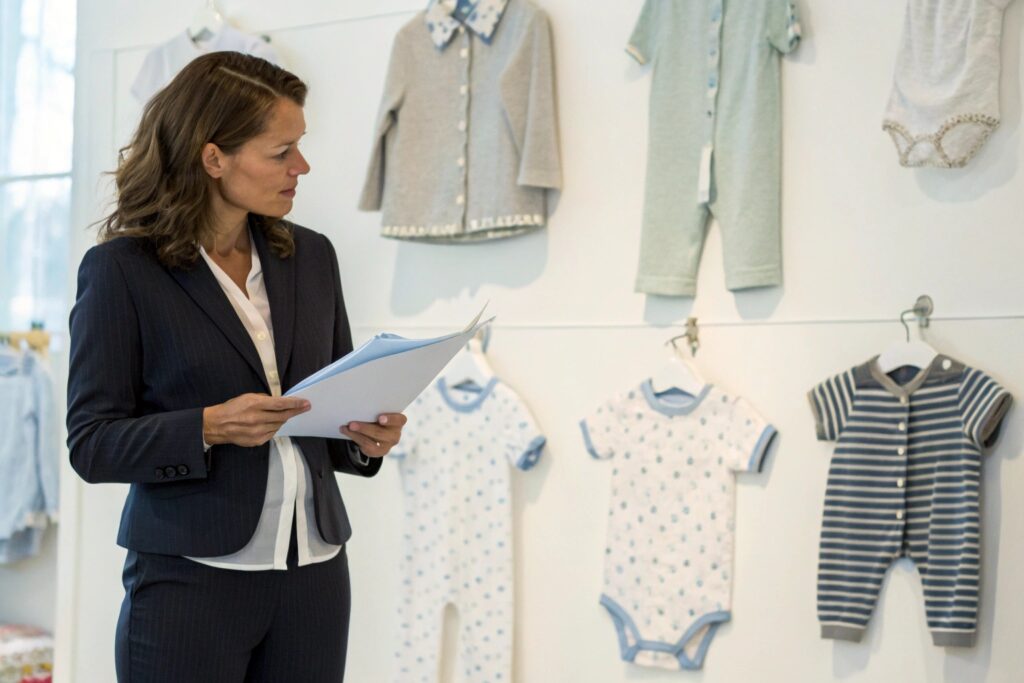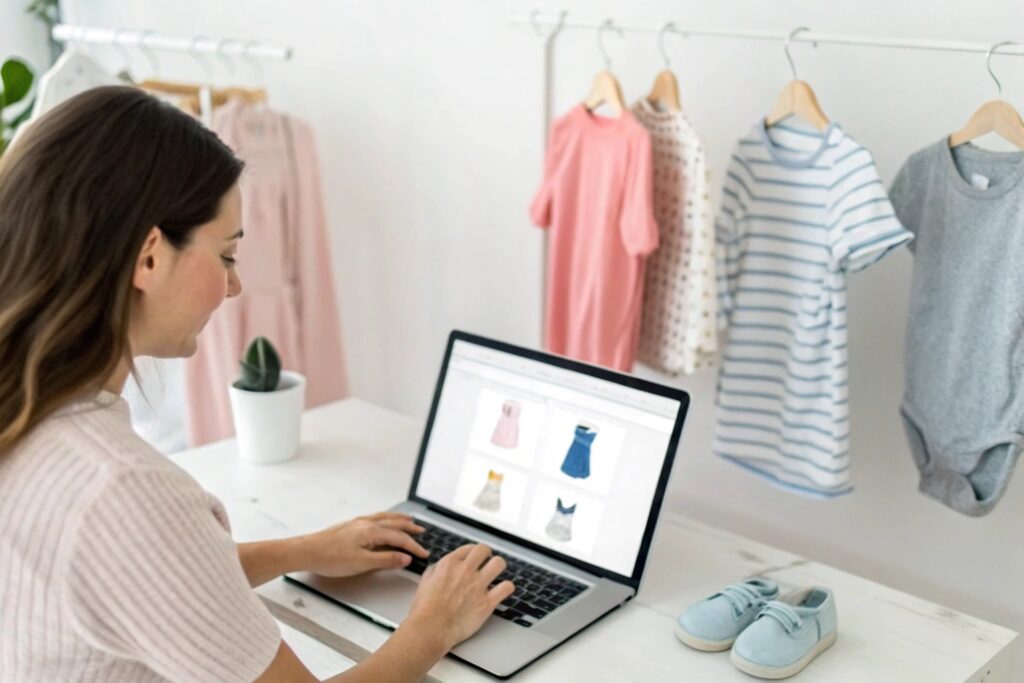Starting a babywear brand sounds exciting—but the cost and complexity can scare off new founders. Is there a low-risk path?
Yes. By starting small with low MOQs, testing demand, and focusing on lean strategies, you can build a babywear brand with minimal risk and maximum learning.
You don’t need a warehouse full of stock or a giant marketing budget to begin. You need the right approach. Let’s explore how to test your idea, sell smart, and scale without overcommitting.
How to Start with Low MOQ and Small-Batch Production?
The biggest risk for new babywear brands is over-ordering before you understand your market. Small batches reduce that risk.
Starting with low minimum order quantities (MOQs) allows new brands to launch quickly, test the market, and avoid dead inventory. Small-batch production gives flexibility and cost control.

Why is small-batch production ideal for testing babywear collections before scaling?
When you order 500–1000 pieces instead of 5000, you free up cash. You get faster production, better control, and quicker feedback. That’s crucial in babywear, where trends shift and sizing needs vary.
Here’s how small-batch compares:
| Production Scale | Ideal For | Risk Level |
|---|---|---|
| Small Batch (200–800 pcs) | New brand launches, style testing | Low |
| Medium Batch (1000–3000 pcs) | Growing DTC brands | Moderate |
| Large Batch (5000+ pcs) | Retail distribution, wholesale | High |
Our factory offers small-batch runs with flexible MOQ for babywear startups. Many of our first-time clients launch with just 3–5 SKUs in 2–3 sizes and colors—enough to test without overwhelming inventory.
How can you find the right babywear manufacturer willing to work with low MOQs?
Look for babywear-specific OEMs that advertise low-MOQ support. Prioritize:
- Factories with 1–5 production lines (more flexibility)
- B2B platforms with startup-friendly filters
- LinkedIn or email outreach to direct contacts (skip Alibaba mass filters)
Also, ask upfront: “What is your MOQ for size, color, and style combinations?” That tells you if they’re flexible or rigid.
Why Pre-Orders and Market Testing Reduce Upfront Costs?
Inventory is expensive. One of the best ways to lower your risk is to sell before you produce.
Pre-orders allow you to confirm demand before investing in full production. Combined with lightweight market tests, this model cuts waste and builds confidence.

How do pre-orders help new babywear brands validate product ideas without overspending?
With a pre-order, you don’t pay for stock upfront. You launch a product online, promote it to your community, and only produce what people buy. This lowers cash risk, and you also get:
- Real customer feedback before committing
- Product validation for investors or partners
- An engaged early audience
We’ve helped several babywear startups do just that. One client launched a gender-neutral romper with 50 preorders in week one—enough to pay for production and profit.
Here’s how a lean preorder model might look:
| Step | Action |
|---|---|
| Design Sample | 1–2 physical prototypes or 3D mockups |
| Launch Preorder | On Shopify, Kickstarter, or your site |
| Promote via Social | Organic posts, ads, parenting forums |
| Close Preorder Window | Usually 2–4 weeks |
| Produce to Order | Based on actual purchase volume |
What testing tools can help validate a babywear product idea before mass production?
- Landing pages (e.g., Carrd or Shopify): See who clicks “I want this.”
- Instagram polls: Ask about color, fit, style preferences.
- Waitlists: Build urgency with “Join the list—launching soon.”
- Digital ads: Test product-market fit with $100 in Meta ads.
How to Choose Safe, Scalable Materials for Babywear?
Material choice impacts everything—price, comfort, safety, and future scale. Don’t overlook it.
Choose certified, baby-safe materials like OEKO-TEX® organic cotton. Pick fabrics available in bulk to ensure long-term consistency and scale.

Why is fabric selection one of the biggest risks for new babywear brands?
Because you don’t want to build your collection around a fabric you can’t reorder. Or worse, one that causes skin irritation.
Here’s what startup babywear brands often face:
- No test reports: Unverified fabrics = safety risks
- Inconsistent stock: Mills stop producing certain blends
- Scaling issues: Small-batch fabrics don’t scale affordably
We recommend fabrics that meet these criteria:
| Fabric Type | Benefits | Good For |
|---|---|---|
| Organic Cotton | Safe, soft, eco-friendly | Newborn rompers, onesies |
| Cotton-Spandex | Stretch, durable | Leggings, tees |
| Bamboo Jersey | Smooth, breathable | Pajamas, sleepwear |
Always ask your factory if they support third-party testing (e.g., OEKO-TEX or GOTS). Also, request bulk availability confirmation: “Can this fabric be sourced in 6 months, in 1000m+ quantities?”
What are cost-effective ways to source safe fabrics without breaking your launch budget?
- Use ready-stock materials: These are in-stock fabrics suppliers already have.
- Start with 1–2 base fabrics: Reduce complexity in your first collection.
- Ask for factory scraps: For sampling, many mills offer cheaper fabric leftovers.
Don’t reinvent the wheel. Use what’s already proven and scalable.
Tips for Building a Lean, Direct-to-Consumer Brand?
You don’t need a warehouse or team to build a powerful brand. You need clarity, focus, and the right tools.
To build a lean babywear brand, use a simple eCommerce setup, talk to a specific audience, and reinvest profits into growth—not stockpiles.

How can new babywear founders sell directly to customers with minimal setup?
Start with these tools:
| Tool | Use |
|---|---|
| Shopify | Website + payments + inventory |
| Klaviyo | Email capture + marketing |
| Canva | DIY social media & packaging design |
| Google Sheets | Order tracking + cost planning |
| Instagram/TikTok | Organic reach + customer feedback |
You don’t need an office. You don’t need 20 products. Start with 3–5 well-made, highly-targeted SKUs. Focus on storytelling, product photography, and answering DMs. That’s what builds trust.
What lean habits help reduce risk and grow sustainably?
- Track every cost: From fabric to packaging to ad spend
- Talk to customers: Ask how the product fits, feels, and washes
- Outsource later: Do your own shipping, customer service at first
- Set a reorder trigger: Restock only when 70% of inventory sells
The best brands aren’t the flashiest—they’re the most focused.
Conclusion
Launching a babywear brand with low risk is possible. Start small, test fast, choose smart fabrics, and grow lean. Your goal isn’t to launch big—it’s to launch smart.










